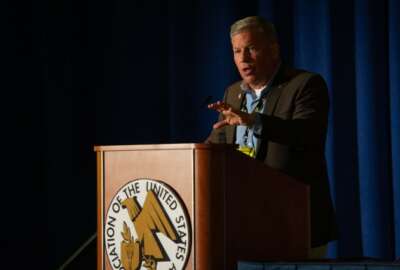
Army Corps of Engineers working with new, improved way of temporary roofing during disasters
When storms damage buildings, a chief rescue activity by the Corps is preventing further damage with blue tarps. The roofers are on the job in Louisiana with an...
Best listening experience is on Chrome, Firefox or Safari. Subscribe to Federal Drive’s daily audio interviews on Apple Podcasts or PodcastOne.
The Army Corps of Engineers calls it their roofing mission. When storms damage buildings, a chief rescue activity by the Corps is preventing further damage with blue tarps as temporary roofs. The blue roofers are on the job in Louisiana with a new and improved way of doing the roofing mission. With details, the commander of the Corps’ Mississippi Valley Division, Maj. Gen. Diana Holland, joined Federal Drive with Tom Temin.
Interview transcript:
Tom Temin: General Holland, good to have you back.
Maj. Gen. Diana Holland: Well, thank you for having me back Tom.
Tom Temin: Give us the ground situation there in Lake Charles. I guess the Corps is at work now in the aftermath of the hurricane.
Maj. Gen. Diana Holland: Yes. It’s been 13 days since landfall, and actually 22 days since we started really paying attention to the approaching storm. And really, to go back a little bit, we were at the time concerned about two tropical storms, Marco and Laura. Fortunately, Marco did not turn out to be a hurricane but Laura made landfall as a strong Cat-4 hurricane in southwestern Louisiana. So we’ve really been working on this in Louisiana for some time but landfall is what brought us into full strength. And we’re doing a number of things. Infrastructure assessment, there was a lot of damage to the systems, water systems and wastewater systems. We’re doing our temporary power mission, which you see pretty much every storm, the Corps assists with point generation for critical facilities. And then as you mentioned, the temporary roofing mission is just now ramping up.
Tom Temin: And what is the difference this time around? You’ve sort of revised the procedures for the roofing mission, Is this because of pandemic or because there’s some new technologies available — or maybe a little both?
Maj. Gen. Diana Holland: Well, that’s a great question. Really what got us started on this, to do this faster and better, was just the need. Three years ago in 2017, we really did a lot of blue roof missions in the Virgin Islands, in Florida, in Puerto Rico. Really historic levels that year. And when we came out of that, I mean, we were successful, but we wanted to be faster and better. And we wanted to meet the need in a much more efficient way. And so over the last three years, it’s been a progression of using contractors to help us with the assessments and some other things. And if I could just describe the mission real quick. Basically what this requires is a homeowner has to sign up and grant right of entry because we represent the federal government, the contractor represents the federal government, and then homeowner has to grant access. So that’s the first step. So we have to set up a number, used to be they had to be in person signups. And you can just imagine when there’s thousands of people affected by a hurricane, what that would be like to develop centralized locations across the state so that folks could go and sign up and grant right of entry. And then the next step was to go to their address, a Corps employee would go to that person’s address, assess it, validate that it meets the requirement, and then put that application into a system, thereby generating a work order, which then brought a contractor to the home. So you can just imagine how long that would take for the first roof. And then for number 4500, if that’s how many were required. So over the last few years, we’ve developed new ways so that it’s not so labor intensive and not so time intensive and not so paper intensive. So one of the things we’ve done and it’s really come to fruition this year is alternative ways to sign up for the blue roof program. And so now there’s three ways you can sign up on the web, you can call in, or you can do it in person. So what that’s allowed us to do is take applications even before we’ve been able to establish in person centralized locations for those signings. So that’s one thing that’s really cut down on the time. The other thing is all those Corps employees that would have to go out and physically check a roof and take measurements and validate the requirement, we’ve since contracted that out, and a company that uses geospatial technology does that from imagery from above. So that’s hundreds a day that can be assessed without one person on the ground to go do that manually. And that’s about an 80% success rate. What we’re seeing is that many are validated just through the use of imagery, and then it’s just a matter of that leaves us with the remaining 20% that we got to go out and check.
Tom Temin: And the imagery, is that obtained by satellite or by drones?
Maj. Gen. Diana Holland: We’ve done it both ways. I’m not 100% certain which technology that the company that we’ve hired to do that now, but I believe it to be satellite. But we have in the past, a year ago, before we came up with this solution, we have used UAS to go over and asses a roof. And actually, we’ve also used it to then go behind and do the quality assurance, because that’s our final step in the process after the contractors done to validate that they did it the right way, and that they should be paid for their services. We have to go out and assess how they did, and we’ve done that us UAV-UAS.
Tom Temin: I was gonna say you have to probably get fairly close to make sure that it’s really done. Well, I mean, a satellite image could show whether there’s a blue roof, I guess, but it wouldn’t show whether it’s nailed down tightly over the edge of the roof to the side safe.
Maj. Gen. Diana Holland: Yeah. And, and they can get pretty close. But yes, we would prefer to be closer to it to validate the work done.
Tom Temin: And because people need to be separated and all this and masked and so forth, because of the pandemic, how has that affected the Corps work, at least in the Mississippi Valley division?
Maj. Gen. Diana Holland: Well, for the hurricane and emergency response, we’re being very careful about how many people we send to Louisiana, Louisiana is of course struggling with with COVID itself. They’ve been very aggressive about putting evacuees and survivors into hotels, which they have contracts as opposed to putting people in sheltering and congregiate environments. So we’re sensitive to that, that a lot of hotels are really needed for survivors. And so we are really limiting how many people we send. And so we’re doing a lot virtually, there’s a lot of reach back and a lot of folks from around the country and in the Corps of Engineers supporting it from afar, and we’ve been able to balance that pretty appropriately. In the grand scheme of things since we went to mostly telework in March of this year, just number one priority is the safety of our personnel. And so a lot of folks are working from home unless their mission essential or if they must do their task from the office or from their field environment. As you know, the Corps does a lot of work from locks and dams and hydropower plants, so they’re out in the field. You really can’t do those jobs from home, you really can’t telework. And so we’ve had to adapt shift work, with limiting access. And then being very careful. As soon as we are aware of a case, taking quick action, notifying people and containing any kind of spread that there might be. But by and large, we’ve really been pleasantly surprised. The Corps hasn’t missed a beat. We’ve met really every milestone in planning. Our projects have moved on, our programs have moved on, really, with very little impact overall from the virus.
Tom Temin: And just briefly what else is going on in the division and how are some of those projects going because you think of, especially in the hurricane season, there must be levees you’ve got to work on or dams that need shoring up?
Maj. Gen. Diana Holland: Well, you know, shoring up the levees of the Mississippi River is really something we’re constantly doing, constantly improving the flood control features of the Mississippi River. You see especially in recent years, you’ve seen an increase in flooding in the Midwest. It’s becoming quite commonplace, which is causing some damage to the levees. And so a lot of work is being done to repair and to improve the resiliency of the levee system. Likewise, since Katrina, the American taxpayer has invested over $14 billion to build a more resilient system around New Orleans. And so that is always on the forefront of our mind. Of course, it was a very visual event for everybody what occurred in New Orleans and very unfortunate. So we’ve invested a lot in that. The New Orleans district that is in charge of that particular system and the state of Louisiana is very vigilant in taking care of the state and ensuring that all the new infrastructure is working. It is now under the state’s control, they actually operate it. But of course, we have a role in assisting them and advising them in advance of any kind of storm.
Tom Temin: And recently, the Army Corps of Engineers listed online a national levee database. How’s that been going? Has there been a lot of hits? Are people doing a lot of exploring on there?
Maj. Gen. Diana Holland: Yeah, this is a great initiative, making sure that we can catalog all of the federal levees and understand the status that they’re in. It’s so far been a great success. So what that helps everyone to do is focus where the most repairs are needed, where we are most vulnerable, so that as we get money to improve the levees across the nation, we’re able to focus that funding in the right direction.
Tom Temin: Major General Diana Holland is commander of the Mississippi Valley division of the US Army Corps of Engineers. Thanks so much for joining me.
Maj. Gen. Diana Holland: Thank you, Tom. Appreciate the opportunity.
Copyright © 2025 Federal News Network. All rights reserved. This website is not intended for users located within the European Economic Area.
Tom Temin is host of the Federal Drive and has been providing insight on federal technology and management issues for more than 30 years.
Follow @tteminWFED






